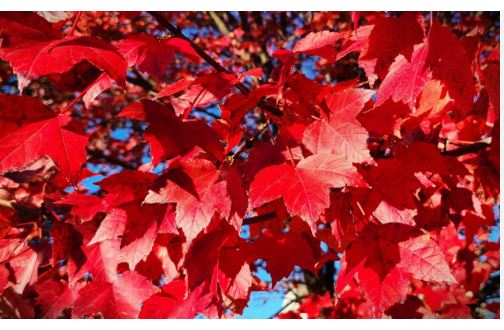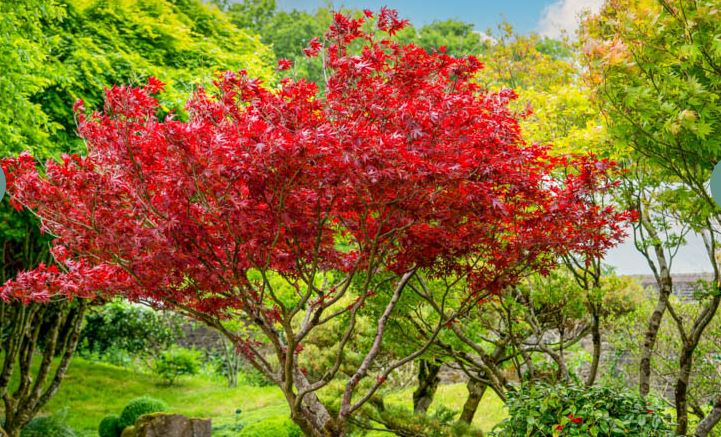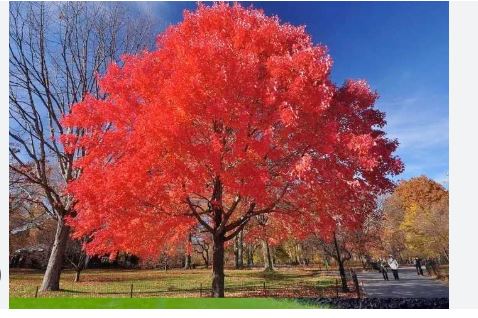
The Red Maple (Acer rubrum), often called the Scarlet Maple or Swamp Maple, is a versatile and iconic deciduous tree native to North America, celebrated for its vibrant red fall foliage, rapid growth, and adaptability to diverse environments. Renowned for its striking seasonal colors, ecological contributions, and widespread use in landscaping, this tree is a cornerstone of forests and urban landscapes alike.
Its cultural significance and practical applications, from syrup to timber, enhance its value. In this detailed guide, we explore the botanical classification, history and native area, identifying characteristics, habitat, distribution, USDA hardiness zones, uses, and fascinating facts about the Red Maple.
Botanical Classification, History and Native Area
The Red Maple, scientifically named Acer rubrum, belongs to the Sapindaceae family, which includes maples, horse chestnuts, and lychees. The genus Acer encompasses over 150 maple species, with Acer rubrum classified in the section Rubra due to its characteristic red-tinged buds, flowers, and foliage. The species name rubrum, Latin for “red,” reflects its vibrant coloration.
As an angiosperm, it produces flowers and seeds, with a typically monoecious reproductive system, bearing male and female flowers on the same tree, though some trees are dioecious. Its taxonomic relatives include the Silver Maple (Acer saccharinum) and Sugar Maple (Acer saccharum), but the Red Maple’s adaptability and early fall color distinguish it, earning it a prominent place in North American forestry and horticulture.
The Red Maple is native to eastern and central North America, with a history dating back millions of years, as evidenced by fossil records from the Miocene epoch. Its range spans from Newfoundland and southern Quebec to Florida, west to Texas, and north to Minnesota, thriving in diverse ecosystems from swamps to uplands.
Indigenous peoples, such as the Iroquois and Cherokee, used its bark for medicinal teas, its wood for tools, and its sap for sweetener, embedding it in cultural practices. European settlers valued its timber for furniture and its rapid growth for reforestation, naming it for its red foliage and buds. Today, it is a staple in landscaping and ecological restoration, though urban sprawl and climate change challenge some native populations, highlighting its conservation importance.
Identifying Characteristics

The Red Maple is a medium to large deciduous tree, typically growing 40–70 feet (12–21 meters) tall, with some specimens reaching 100 feet (30 meters), and a spread of 25–40 feet. Its canopy is rounded to oval, with a straight trunk and smooth, gray bark that becomes scaly and fissured with age.
Leaves are opposite, palmate, and three- to five-lobed (3–6 inches wide), with serrated margins, green above, paler with a silvery underside, turning brilliant red, orange, or yellow in fall, often among the earliest trees to color. The tree produces small, red flowers in dense clusters in early spring, followed by paired samaras (1–2 inches long) with divergent wings, red when young. Twigs are reddish, with small, pointed red buds, and the tree’s consistent red accents enhance its ornamental appeal.
Habitat
The Red Maple is one of the most adaptable North American trees, thriving in a wide range of habitats, from wetlands and swamps to dry uplands and rocky slopes. It prefers moist, well-drained, slightly acidic soils (pH 4.5–7.0), typically loamy or sandy, but tolerates clay, wet, or moderately dry conditions. It grows best in full sun to partial shade, requiring at least 4–6 hours of sunlight for optimal foliage color and growth.
In its native range, it grows alongside oaks, pines, and poplars, often in mixed hardwood forests, floodplains, or forest edges, where its shallow roots stabilize soils. In cultivation, it adapts to urban parks, gardens, and streetscapes, tolerating pollution, compacted soils, and periodic flooding, but it is sensitive to salt and requires protection from mechanical damage to its thin bark.
Distribution
The Red Maple has one of the broadest ranges of any North American tree, spanning eastern and central North America, from southern Canada (Ontario, Quebec) to Florida, west to eastern Texas, and north to Minnesota and Wisconsin, with its core range in the Appalachian Mountains, Great Lakes, and Atlantic Coastal Plain.
It is a dominant species in both wetland and upland forests, particularly in the northeastern and southeastern U.S. Introduced to cultivation in Europe, Australia, and parts of Asia, it is planted as an ornamental for its fall color and adaptability. Available through nurseries like FastGrowingTrees.com and NatureHills.com, it can naturalize in moist, disturbed sites but is not considered invasive, as its seed dispersal is balanced by ecological constraints.
USDA Hardiness Zones
The Red Maple thrives in USDA Hardiness Zones 3–9, tolerating minimum temperatures from -40°F to 20°F (-40°C to -7°C). It excels in a wide range of climates, from cold northern winters to hot, humid southern summers, making it one of the most versatile maples.
In Zone 3, it withstands extreme cold with mulching and wind protection, while in Zone 9, it tolerates heat and humidity with irrigation and partial shade to prevent leaf scorch. Its broad hardiness range supports its use in diverse landscapes, from rural woodlands to urban streets, ensuring vibrant fall displays and robust growth when soil and moisture needs are met.
Uses
The Red Maple is a multifaceted tree with ornamental, ecological, and industrial applications. Its brilliant fall foliage, ranging from scarlet to orange, makes it a premier ornamental for gardens, parks, streetscapes, and campuses, where its rounded canopy provides ample shade, reducing urban heat. Ecologically, its early spring flowers are a vital nectar source for bees and pollinators, and its samaras feed birds and small mammals, while its branches offer nesting sites, supporting biodiversity.
Its shallow roots stabilize soils in wetlands and floodplains, aiding erosion control in rain gardens. The wood, moderately hard, is used for furniture, cabinetry, crates, and pulp, though less valued than Sugar Maple. The sap, though lower in sugar content, is tapped for artisanal maple syrup in some regions. In urban settings, it sequesters carbon, improves air quality, and enhances stormwater management, though its shallow roots and leaf litter require maintenance planning.
Fun Facts
The Red Maple is rich with captivating facts that highlight its unique appeal. Its vibrant red fall foliage, often appearing as early as September, earns it the nickname “Scarlet Maple,” rivaling the Sugar Maple in autumn brilliance. Its sap was used by Indigenous tribes as a sweetener and medicine, predating European maple syrup production. A record-breaking Red Maple in Michigan stands 125 feet tall, showcasing its potential grandeur.
The tree’s red buds and flowers signal spring’s arrival, attracting early pollinators like bumblebees. Its samaras, nicknamed “helicopters,” spin dramatically when falling, aiding widespread seed dispersal. The Red Maple’s adaptability allows it to colonize disturbed sites, earning it the title “pioneer species” in forest succession. Finally, its wood was historically used to make spinning wheels and gunstocks, reflecting its versatility in early American craftsmanship.
Cultivation of Red Maple (Acer rubrum)

Cultivating the Red Maple (Acer rubrum), a versatile and iconic deciduous tree native to eastern North America, is a rewarding endeavor for gardeners, landscapers, and restoration ecologists seeking a fast-growing, adaptable tree with vibrant red fall foliage and ecological benefits.
Known for its striking seasonal colors, tolerance of diverse soils, and suitability for urban and natural landscapes, the Red Maple enhances gardens, streetscapes, and wetlands but requires careful management to protect its thin bark, manage shallow roots, and ensure optimal health.
- Climate Suitability: Red Maple thrives in USDA Hardiness Zones 3–9, tolerating minimum temperatures from -40°F to 20°F (-40°C to -7°C). It excels in a wide range of climates, from cold northern winters to hot, humid southern summers. In Zone 9, provide irrigation and partial shade during extreme heat to prevent leaf scorch, while in Zone 3, protect young trees from harsh winter winds to ensure survival.
- Site Selection: Choose a location with full sun to partial shade, receiving at least 4–6 hours of direct sunlight daily, to promote vibrant fall color and vigorous growth. Full sun maximizes foliage intensity, though light shade is tolerated in hotter climates. Ensure the site accommodates its mature size (40–70 feet tall, 25–40 feet wide) and avoid planting near sidewalks or foundations, as its shallow roots can cause uplift in confined spaces.
- Soil Requirements: Plant in moist, well-drained, slightly acidic soil with a pH of 4.5–7.0, preferably loamy or sandy, to support healthy growth and coloration. The tree is highly adaptable, tolerating clay, wet, or moderately dry soils, making it ideal for wetlands or uplands. Test soil drainage and amend with organic matter (e.g., compost, leaf mold) to enhance fertility, aeration, and moisture retention, especially in poor soils.
- Planting Time: The optimal planting seasons are early spring or fall, allowing roots to establish before summer heat or winter cold. Use young, container-grown or balled-and-burlapped trees to minimize root disturbance. Dig a hole twice as wide and as deep as the root ball, positioning the root collar at or slightly above ground level. Backfill with a mix of native soil and compost, tamp gently, and water deeply to settle the roots.
- Watering Needs: Water young trees deeply (1–2 times weekly) for the first 1–2 years to establish a shallow but extensive root system, keeping soil consistently moist but not waterlogged. Once established, the tree is highly adaptable, tolerating periodic flooding and moderate drought, but benefits from supplemental watering during prolonged dry spells, especially in warmer zones or urban settings, to maintain foliage health and fall color vibrancy.
- Mulching: Apply a 2–4 inch layer of organic mulch (e.g., shredded bark, wood chips) around the base, extending to the drip line but keeping it 2–4 inches from the trunk to prevent rot and pest issues. Mulch conserves moisture, regulates soil temperature, and protects shallow roots, supporting young trees in gardens, streetscapes, or rain gardens. Replenish mulch annually to maintain its benefits.
- Fertilization: Fertilize young trees in early spring with a balanced, slow-release fertilizer (e.g., 10-10-10 or 5-10-5) to promote rapid growth and robust foliage, applying at half the recommended rate to avoid excessive vegetative growth that weakens structure. Mature trees need minimal fertilization in fertile soils, but a light application every 2–3 years can enhance color and vigor. Avoid high-nitrogen fertilizers, which may reduce fall coloration and increase pest susceptibility.
- Pruning: Prune in late winter or early spring, when the tree is dormant, to remove dead, damaged, or crossing branches and to shape its rounded canopy, using clean, sharp tools to prevent disease spread. Light pruning enhances airflow and light penetration, critical for foliage health, but avoid heavy cuts, as Red Maples are susceptible to fungal infections like verticillium wilt. Remove lower branches gradually for street trees to ensure clearance.
- Pest and Disease Management: Monitor for pests like aphids, scale, or leafhoppers, treating infestations with insecticidal soap or neem oil. The tree is susceptible to fungal diseases such as verticillium wilt, anthracnose, or tar spot in wet or poorly drained conditions; ensure good drainage, improve air circulation, and remove infected debris promptly. Apply fungicides preventatively in high-risk areas, and avoid wounding the thin bark to minimize infection risks.
- Spacing: Space trees 25–40 feet apart to accommodate their mature canopy spread, ensuring adequate sunlight and air circulation to promote foliage health and reduce disease risk. For group plantings or naturalized areas, plant 20–30 feet apart for a cohesive canopy, mimicking forest conditions. Consider their height (up to 70 feet, rarely 100 feet) when planning near structures, power lines, or pathways to avoid conflicts with branches or roots.
- Wind Protection: Young Red Maples, with shallow but extensive roots, are moderately wind-tolerant but may need support in exposed sites to prevent leaning during establishment. Stake newly planted trees for the first 1–2 years using flexible ties to allow slight trunk movement, strengthening roots. Remove stakes once established to prevent girdling. Plant in sheltered locations or use windbreaks (e.g., shrubs, fences) in windy areas to protect foliage.
- Winter Care: In Zone 3, protect young trees from winter damage by wrapping trunks with burlap or tree guards to prevent sunscald, frost cracks, and rodent damage, and mulching heavily (4–6 inches) around the base to insulate roots. Water adequately before freeze-up to prevent dehydration, as deciduous trees lose moisture in winter. Mature trees are highly cold-hardy and require minimal winter care, but monitor for deer browsing in rural areas, especially on young twigs.
- Long-Term Growth: Red Maples grow rapidly (1–2 feet per year), reaching 40–70 feet at maturity, with lifespans of 80–150 years in optimal conditions. Their vibrant fall foliage, early spring flowers, and ecological contributions make them ideal for ornamental landscapes, urban parks, or wetland restoration. Regular monitoring for pests, diseases, and bark damage, combined with attentive care, ensures lasting beauty and environmental benefits, whether as a street tree or forest pioneer.